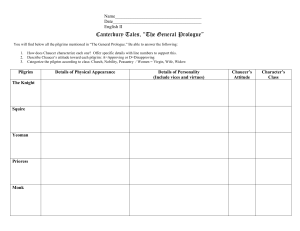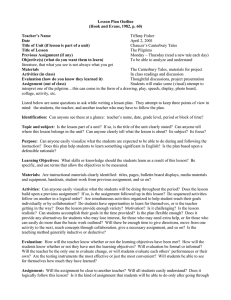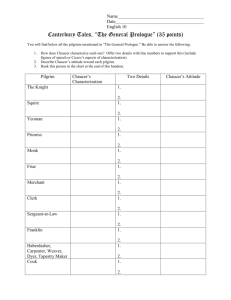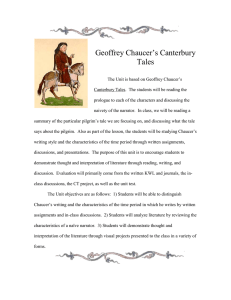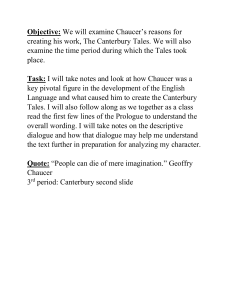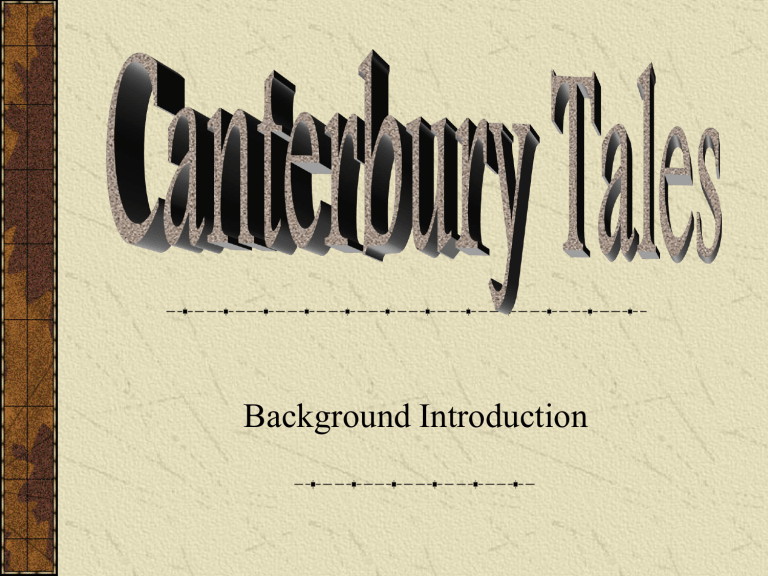
Background Introduction Geoffrey Chaucer c. 1343-1400 Considered the father of English poetry Wrote in the vernacular – common language of the people (English) Served as a soldier, government servant, and member of Parliament Introduced iambic pentameter First writer buried in Westminster Abbey The Journey Begins . . . Chaucer uses a religious pilgrimage to display all segments of medieval England. The Canterbury Tales begins with a Prologue, Narrator, presumably Chaucer himself, meets 29 other pilgrims at the Tabard Inn, located in a suburb of London. As the pilgrims prepare for their journey, the host of the Inn, Harry Bailey, sets a challenge: Each pilgrim tell two stories on the way to Canterbury and two stories on the return trip. The person who tells the best tale will be treated to a feast hosted by the other pilgrims. The Journey Begins . . . The Canterbury Tales is actually a story about stories, twenty-four different tales set within the overarching tale of the pilgrimage. Definition: Frame Story – a story within a story • The Outer Frame Story is about the pilgrims meeting at the Tabard Inn preparing for a journey to Canterbury. • The Inner Frame Story would be all the stories told by the assembled pilgrims along their journey to and from Canterbury. Snapshots of an Era. . . In the Prologue, Chaucer sketches a brief but vivid portrait of each pilgrim, creating a lively sense of medieval life. The description may literally describe an article of clothing, but figuratively imply something about that character. Definition: Satire – to describe in hyperbolic or humorous ways but with intent for change. Our job is to read and comprehend the literal description of each pilgrim, and then, we must figuratively interpret what Chaucer is trying to imply about that pilgrim’s character. Snapshots of an Era. . . In the Prologue, Chaucer examines three segments of Medieval England: 1. The Old Feudal order – these are all of the pilgrims associated with the feudal class system. • Knight, Squire, Yeoman, Plowman . . . 2. The Merchant Class – this was the rising middle class of the time; towns and cities were emerging and therefore necessitated the need for skilled services: • Merchant, Man of Law, Guildsmen, Cook . . . 3. The Ecclesiastical (Church) Class – these were all of the members of the church. Chaucer is most critical of this segment of his society. • Prioress, Monk, Friar, Pardoner . . . A Literary Tour. . . Chaucer uses the popular genres of his time when he creates the inner stories of the various pilgrims: Romances (tales of chivalry) • The Wife of Bath’s Tale Fabliaux (short, bawdy, humorous stories) • The Miller’s Tale The stories of saint’s lives, sermons • The Parson’s Tale Allegories (narratives in which characters represent abstractions such as Pride or Honor). • The Pardoner’s Tale Chaucer wrote much of the Tales using his own form, the heroic couplet, a pair of rhyming lines with five stressed syllables each. Literary Analysis Characterization Direct characterization presents direct statements about a character, such as Chaucer’s statement that the Knight “followed chivalry, / Truth, honor. . . .” Indirect characterization uses actions, thoughts, and dialogue to reveal a character’s personality. By saying “he was not gaily dressed,” for instance, Chaucer suggests that the Knight is not vain and perhaps takes the pilgrimage seriously enough to rush to join it straight from battle.

